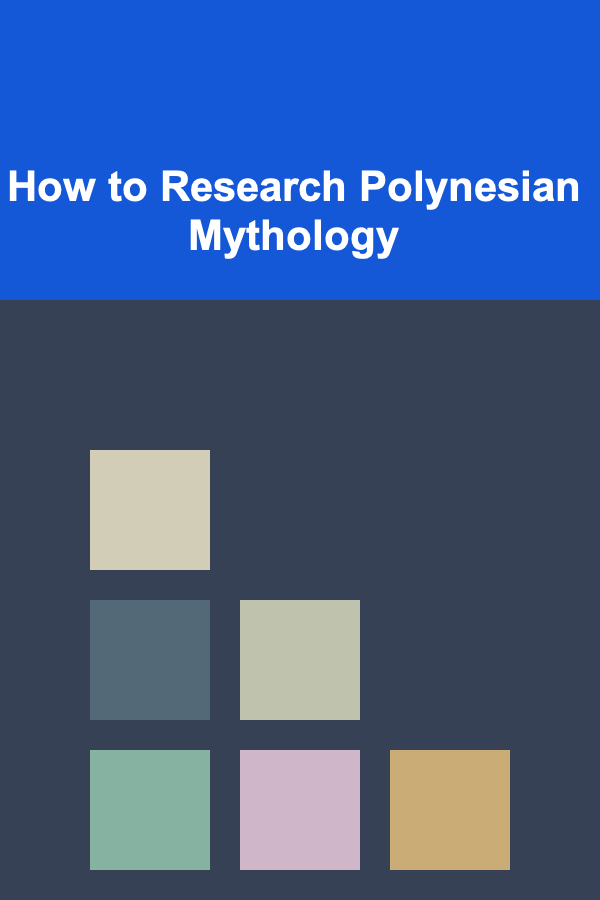
How to Research Polynesian Mythology
ebook include PDF & Audio bundle (Micro Guide)
$12.99$11.99
Limited Time Offer! Order within the next:

Polynesian mythology is a fascinating and intricate tapestry of myths, legends, and beliefs from the Pacific islands, encompassing a diverse range of cultures, deities, and ancestral stories. As a region, Polynesia spans vast distances across the Pacific Ocean, with each island group having its unique traditions and stories. Researching Polynesian mythology requires not just understanding the individual myths themselves but also delving into the broader cultural, historical, and linguistic contexts that shape them.
This guide explores how to research Polynesian mythology effectively, offering insights into reliable sources, key themes, and research strategies that will provide a deeper understanding of these myths.
Understand the Geography and Cultural Diversity of Polynesia
Before diving into the specifics of Polynesian mythology, it's important to grasp the geographical and cultural diversity of the region. Polynesia is made up of a vast collection of islands scattered across the central and eastern Pacific. It includes well-known island groups such as:
- Hawaiian Islands (Hawaii)
- Tongan Islands (Tonga)
- Samoan Islands (Samoa)
- Maori of New Zealand (Aotearoa)
- Tahiti and the Marquesas (French Polynesia)
- Rapa Nui (Easter Island)
Each of these island groups has its own distinct culture, language, and mythology, although there are many shared elements due to the common Austronesian language family and long-standing cultural exchanges across the Pacific.
Researching Polynesian mythology requires an understanding of these cultural nuances. The stories and deities of one island group might differ from those of another, so contextualizing each myth in its regional setting is key.
Start with Reliable Primary Sources
When researching any mythology, primary sources are crucial for an authentic and in-depth understanding. For Polynesian mythology, primary sources typically come from early European explorers, missionaries, and native oral traditions. While European accounts can provide useful historical context, the most important primary sources come from the indigenous peoples themselves.
Oral Traditions
Polynesian mythology is largely transmitted through oral tradition. These stories are passed down from generation to generation, often through chanting, song, and ritual. This means that the myths and legends of Polynesia can vary in detail, depending on the storyteller and the island group. Oral tradition also has a deep connection with rituals, ceremonies, and the daily lives of the people, making these myths more than just stories; they're a living part of the culture.
Written Accounts from Early Explorers and Missionaries
In the 18th and 19th centuries, European explorers and missionaries began documenting Polynesian myths and legends. While their accounts may be biased or incomplete, they provide valuable historical data. Notable sources include:
- Captain James Cook's Voyages: Cook's writings and journals during his explorations in the Pacific provide early European observations of Polynesian customs and myths.
- Missionary Writings: Missionaries, such as those from the London Missionary Society, wrote about Polynesian religion and mythology. While these writings often reflect a colonial mindset, they still offer some of the earliest comprehensive accounts of Polynesian beliefs.
Though these accounts should be read critically, they are invaluable for understanding the mythological themes that fascinated Europeans at the time.
Translations and Transcriptions of Oral Epics
Some Polynesian cultures, like the Hawaiians, have collected and transcribed their oral traditions into written texts. These translations often appear in collections of myths or legends, such as:
- The Hawaiian Legends by Martha Warren Beckwith
- Tales of the Maori by A.W. Reed
- Samoan Mythology by M. K. Brown
These written versions of oral stories allow researchers to study myths more systematically and compare them across regions.
Explore Key Themes and Deities in Polynesian Mythology
Polynesian mythology, while diverse, shares certain core themes and deities across its many island cultures. Understanding these commonalities can provide a foundation for deeper research.
The Creation of the World
Many Polynesian myths share a creation story that involves gods and cosmic forces shaping the world. For example, the Māori of New Zealand have a well-known creation myth that tells of the separation of the sky and the earth, personified as the gods Rangi (the sky) and Papa (the earth). Their children, gods themselves, play key roles in the creation of the world as we know it.
Similarly, in Hawaiian mythology, the creation of the world is attributed to the god Kāne, who is associated with light, life, and the creation of humans.
Gods and Goddesses
Polynesian cultures are rich with a diverse pantheon of gods and goddesses who represent natural forces, aspects of daily life, or cultural ideals. Some of the most significant deities include:
- Tangaroa: The god of the sea, present in most Polynesian cultures, including Māori, Hawaiian, and Tahitian traditions.
- Māui: A legendary trickster and hero figure who is credited with many feats, such as fishing up the islands or slowing the sun.
- Pele: The Hawaiian goddess of volcanoes and fire, known for her passionate temper and dramatic stories of creation and destruction.
Each deity has a unique role within the mythos of the island cultures, and understanding their symbolism is key to comprehending Polynesian mythology in its entirety.
Creation of Humans and Ancestral Stories
Polynesian mythology often centers around stories of creation, not only of the world but also of human beings. These creation myths are tied to ideas of ancestry and divine heritage. For example, many Polynesian cultures trace their origins back to gods or divine ancestors, with significant emphasis placed on genealogies and the importance of maintaining one's ancestral connection.
In Māori mythology, the creation of humans is often linked to the god Tāne , who is said to have created the first woman, Hineahuone , from the earth. Similarly, in Hawaiian mythology, humans are often depicted as being made from sacred elements by gods like Kāne.
Heroic Myths and Legendary Figures
Many Polynesian myths are centered around heroic figures, often gods or semi-divine beings, who perform extraordinary feats. These heroes often shape the landscape, create cultural traditions, or fight against malevolent forces. Some of the best-known Polynesian heroes include:
- Māui, the demi-god trickster, who is famous for many acts of cunning and bravery.
- Tūmatauenga, a Māori god of war who is central to many myths about the origins of conflict.
These stories often serve not just to entertain but to teach lessons about human nature, bravery, and the consequences of one's actions.
Understand the Role of Mythology in Polynesian Culture
Polynesian mythology isn't just a collection of old stories---it plays an active role in the lives of the people. Myths are intricately woven into rituals, ceremonies, and daily life. For example:
- Rituals and Ceremonies: Many Polynesian myths are enacted in traditional rituals and ceremonies, such as those surrounding life stages (birth, death, marriage) or agricultural events like planting and harvesting.
- Place Names: Many places across Polynesia are named after myths, gods, or legendary events. For example, certain sacred locations are said to be the homes of gods or ancestors, and visiting these places is often seen as a way of connecting with the divine.
Thus, researching Polynesian mythology means exploring how these myths are lived and experienced within the culture.
Use Academic Resources and Secondary Sources
After studying primary sources, it's essential to deepen your understanding of Polynesian mythology by using academic resources. Scholars who specialize in anthropology, linguistics, and religious studies often publish detailed research on Polynesian cultures and their mythologies. Key secondary sources include:
-
Books: Many scholars have written books specifically about Polynesian mythology, such as:
- Mythology of the Polynesians by William H. R. Rivers
- Polynesian Mythology by Sir George Grey
-
Journals : Academic journals like The Journal of the Polynesian Society often publish studies on specific aspects of Polynesian myths, ranging from genealogies to symbolic analysis.
-
Online Databases: Websites and digital archives related to Pacific studies often contain collections of translated myths, oral histories, and research articles that are invaluable for serious scholars.
Pay Attention to Linguistics and Language
Language plays a crucial role in understanding Polynesian mythology. Many Polynesian languages contain deep layers of meaning, especially in relation to storytelling, names, and divine figures. Understanding key linguistic features, such as:
- Metaphor and Symbolism: Polynesian languages are rich in metaphor and symbolism, so understanding these nuances is crucial for interpreting myths correctly.
- The Role of Oral Tradition: Polynesian myths are often passed down through song, chant, or poetry. Therefore, a focus on phonetics and rhythm is important when studying these oral traditions.
Conclusion
Researching Polynesian mythology is an enriching and multifaceted journey that goes beyond simply reading stories. It involves understanding the deep connections between culture, history, and belief systems. By starting with primary sources, understanding the key themes and deities, and considering the broader cultural context, you can gain a more comprehensive and meaningful appreciation for these rich and vibrant myths.
Reading More From Our Other Websites
- [Organization Tip 101] How to Keep Learning and Growing While Working Remotely
- [Personal Investment 101] How to Invest in High-Growth Tech Stocks for Long-Term Potential
- [Home Storage Solution 101] How to Maximize Storage in Tiny Bathrooms
- [Organization Tip 101] How to Choose the Right Colors and Textures for a Sensory Room
- [Home Family Activity 101] How to Master Family Charades for Hilarious Game Nights: Tips, Tricks, and Theme Ideas
- [Stamp Making Tip 101] Setting Up Your Home Stamp Workshop: Tools, Tips, and Safety for Newbies
- [Home Maintenance 101] How to Maintain Your Home's Security System for Safety and Efficiency
- [Home Security 101] How to Keep Your Home Safe During the Holidays
- [Home Budget Decorating 101] How to Style Shelves Like a Pro on a Budget: 5 Simple Styling Secrets
- [Simple Life Tip 101] How to Design a Relaxing Evening Routine That Enhances Your Simple Life Feelings

Creating a Passive Income Stream with Deep Learning in E-commerce
Read More
How to Add a Blog to Your Website: A Simple Checklist
Read More
How to Organize Creative Supplies for Artists and Designers
Read More
How to Create a Mood Board for Your Design Project
Read More
How to Ace Your PA School Interview
Read More
10 Tips for Finding the Best Wedding Photographer for Your Style
Read MoreOther Products

Creating a Passive Income Stream with Deep Learning in E-commerce
Read More
How to Add a Blog to Your Website: A Simple Checklist
Read More
How to Organize Creative Supplies for Artists and Designers
Read More
How to Create a Mood Board for Your Design Project
Read More
How to Ace Your PA School Interview
Read More